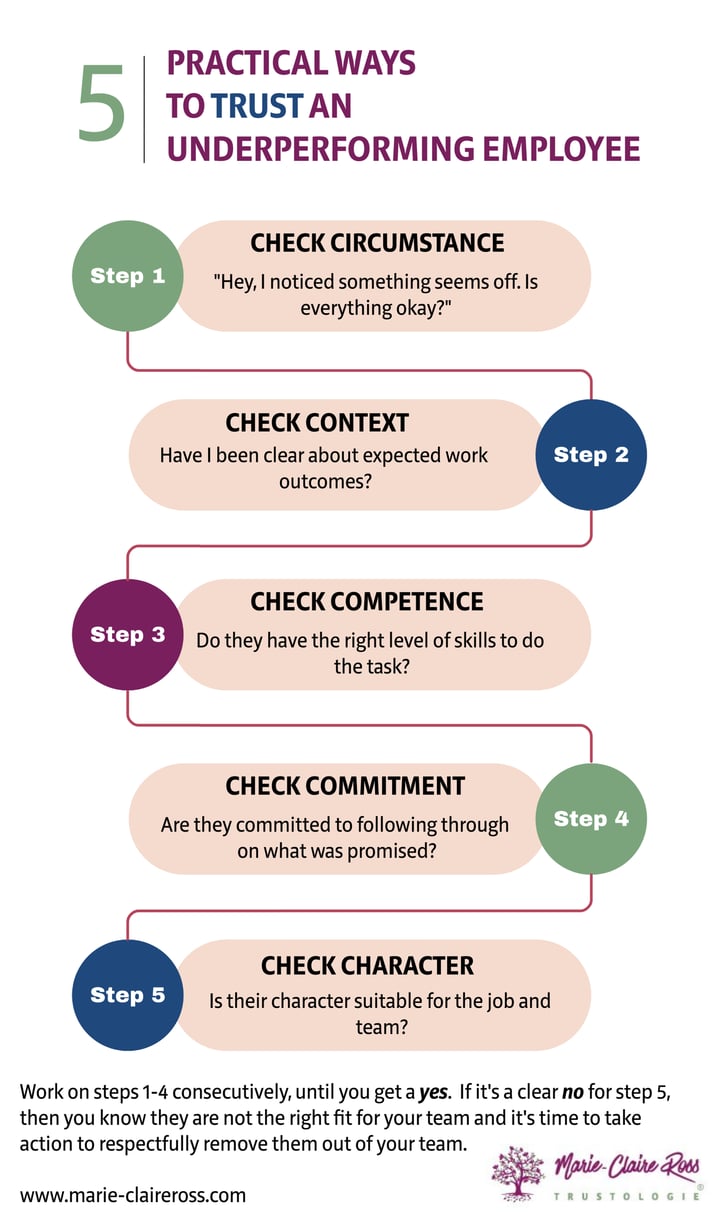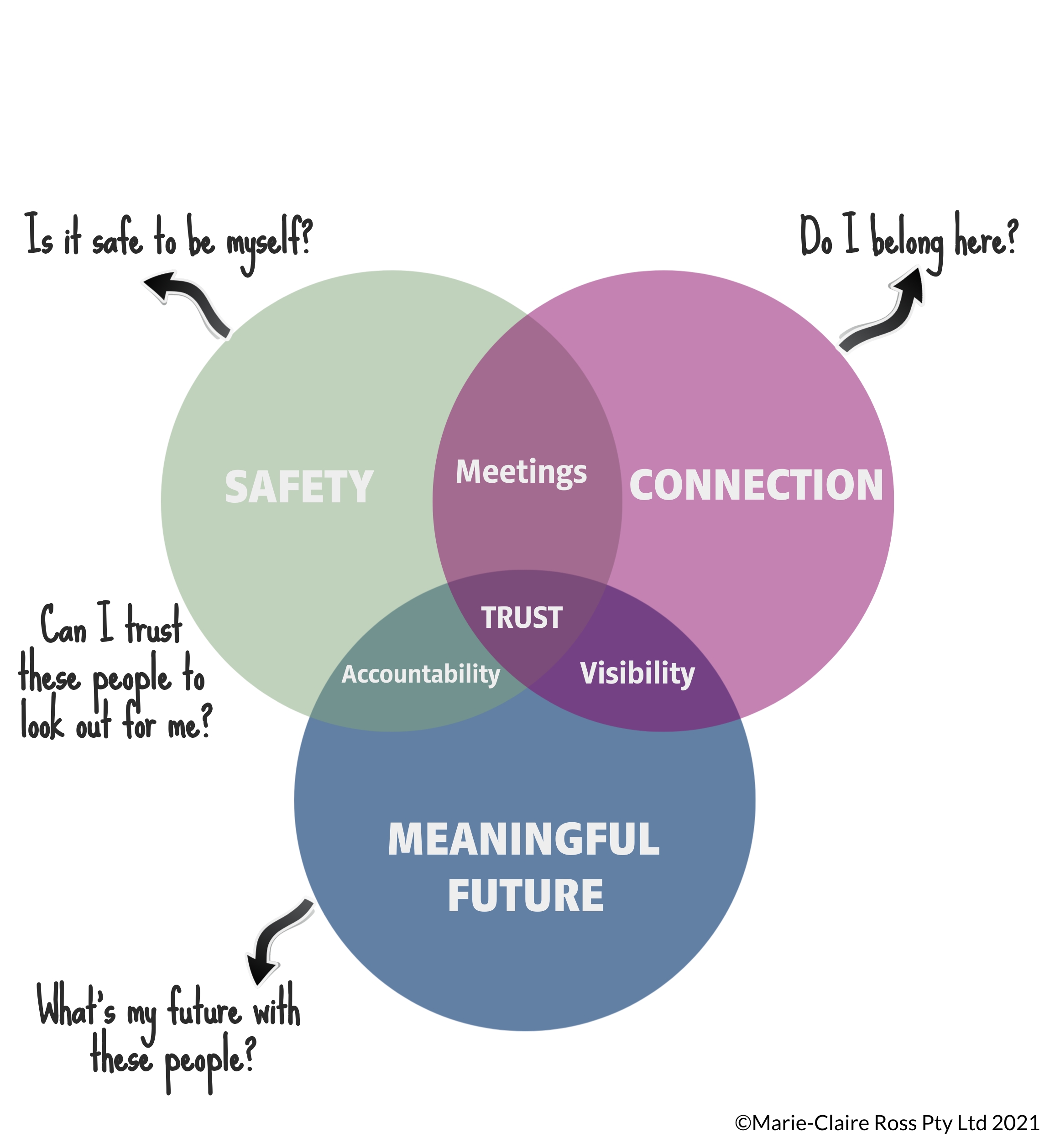When faced with an employee who consistently falls short of meeting job expectations, what steps can you take to address the situation effectively?
Trust in an employee is built upon our confidence in someone's ability to consistently deliver high-quality work, on time and within the allocated resources. But when they repeatedly let you down, it is understandable to not trust them.
So what can you do when you can't trust an employee to deliver?
Use a process to help you ascertain where you don't trust them, so you can provide the right support. A process that is fair to both you and them.
Let's take a look.
1. Circumstance
Sometimes direct reports drop the ball because they have a personal issue getting in their way.
Taking the time to emotionally check in with someone first, rather than jump to conclusions is the hallmark of a
trusted leader.
Asking the question, "Hey, I noticed something seems off. Is everything okay?" is a much better first step than assuming that they are deliberately doing the wrong thing.
It's also about ensuring that they are not overloaded. This is particularly important for younger or new employees who might say "yes" to every task because they have not learnt to prioritise their workload. Asking "Is your workload too heavy to manage?" helps you ascertain whether that's causing them to miss the mark.
Trust gets broken when we don't consider the person doing the work and take the time to understand their situation. If things are okay here, it's then time to consider context.
2. Context
Context is about evaluating whether you have provided them with the right information and resources to complete their task.
It's a common managerial practice to skip a contextual conversation in preference for speed. But it will cost you down the line.
Taking the time to make they are set up for success requires reflecting on whether you have clearly communicated:
- The purpose of the work.
- Who benefits from the work? What are we trying to accomplish?
- How does the work fit in with other tasks?
- How does their unique contribution support business outcomes?
- What does good and bad look like - to you and the end user?
- Your expectations around timing, budget, safety and quality.
- What resources they need and how to request more.
- Consequences if they didn't complete the work to standard.
This step requires considering what you might be doing to get in their way. If you are not sure as to whether you are clear about expected work outcomes, then ask them to tell you what they think the outcome might be. Whether that is the purpose, what good looks like or what needs to be done by when.
If context is clear, then we need to consider their competence.
3. Competence
A common reason for poor performance is that an employee doesn't have the requisite skills or knowledge to do what you ask. Addressing competency breaches of trust is relatively easier since we can assist the employee in improving their skills or finding a better fit in a different role.
This requires assessing their level of capability to do the task. Inquire as to whether they have done the task before or received training. If not, then you need to take the time to share effective approaches and provide examples from previous projects.
Making sure to check in with them as to how they plan to approach the task, so you can course correct with further questions that direct their attention such as "What steps will you take ensure the data is correct?"
It also means being available for questions and encouraging them to come back to you with 2-3 ideas when they get stuck, so you can help them select the right approach.
Checking in to ensure they have the right level of competence reduces the likelihood of having unreasonable expectations. It also gives you the opportunity to provide more training to help them.
When there is a mismatch between your expectations and an employee's capabilities, it's important to adapt your approach. Take a moment to reflect and ask yourself, "Are my expectations realistic?" This will help you align your expectations more appropriately with their skill level.
But if they are still underperforming we need to check their level of commitment.
4. Commitment
So far we have talked about how circumstance, context and capability impact performance. The fourth possibility of poor performance is that they lack commitment.
This is much trickier to turn around and it involves considering, "Are they committed to following through on what they promised? Do they have the motivation to get the job done?"
As Christine Comaford says in her book,
Smart Tribes, when an employee
repeatedly drops commitment we must find out the underlying cause. Asking them “What do you want? What will having that do for you? When will you know when you have it?”
Helping employees get clear on how the work benefits themselves and others around them, works towards shifting them to keep their commitments.
This often requires reiterating consequences of poor quality to work to boost motivation. This might be communicating how successful delivery is linked to positive outcomes such as new skills learnt, happy clients, making them feel good about themselves and future opportunities. While pointing out negative ramifications such as unhappy clients or limited opportunities.
If they are still underperforming, we need to check their character.
5. Character
Character is about how people demonstrate values such as integrity, respect, courage, fairness and inclusion. It is about their motive and intent when working with others.
Even if an employee excels at their job, their lack of honesty undermines their trustworthiness.
If a direct report has been given the right understanding towards their personal circumstances, received compelling information about the context, supported to improve their capabilities and commitment, then their character is in question.
Character issues are also the most difficult to turn around because their behaviours give away whether they really want to work at the company. It makes us question whether they are a cultural fit, if they cannot be trusted to live the right behaviours. Ask yourself "Is their character suitable for the job?"
If the answer is negative, it is crucial to engage in an open and honest dialogue about their desire to continue their employment within the organisation, in order to ensure the fulfilment of everyone's needs. If they want to continue in their role, it's time to work with them to design a plan to meet performance standards by a clear end date.
Managing an Underperforming Employee
To improve work performance, it's a typical human approach to think the worst of someone. We default into judgement thinking "They are deliberately trying to slow things down" or "Why are they so stupid?" We tend to negatively judge a person's character.
This sort of internal dialogue is not helpful. It's also even more disastrous if we verbalise our internal negative thoughts.
To avoid the compelling tendency to blame an employee for their poor performance, we need to step back and assess their personal circumstances, whether they know the context of their job, their level of capability and their commitment to the job. Only then can we start to question their character with the positive intent to align them, not malign them.
When employee performance declines, stop defaulting to distrusting the person and move to trusting a process to support them with improving.
Remember, trust takes time to build, but with patience, empathy, and support, you can empower your underperforming employee to reach their full potential.
Use these five steps to remove the tendency to remove unhelpful negative emotion and personal biases when an employee underperforms. Combined with the
positive intent to help others be their best, it also demonstrates that you are an ally, not an enemy.
And that is the work of a trusted leader.


